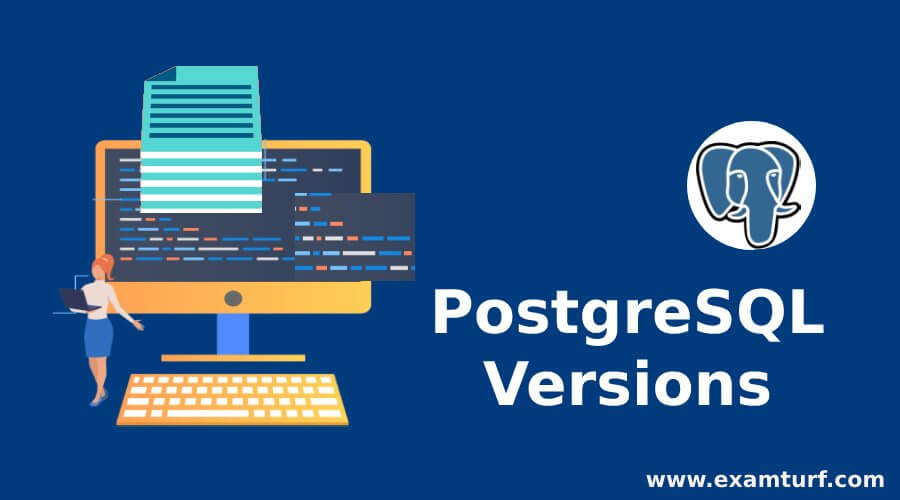
Introduction To PostgreSQL Versions
The following article provides an outline for PostgreSQL Versions. PostgreSQL is a well-known, popular RDBMS [Relational Database Management System] which is useful to store the data with security and also it recovers the data whenever is needed. Initially, in 1996 PostgreSQL was introduced at the University of California that uses C Programming language and it also supports various platforms such as Unix, Microsoft Windows, Linux, Mac OS X, Solaris, etc. PostgreSQL allows the facility to add custom functions, different coding languages, data types, which is useful to increase the reliability of the particular organization. One of the best objectives of PostgreSQL is to handle a variety of jobs in web service with several users.
Versions Of PostgreSQL
- Version is a process of classification of particular software according to the advanced feature with updates.
- Several versions are released from Postgre 95 to PostgreSQL 1.
Features of PostgreSQL Versions
Specific features of each version is as follows:
- Postgre 95: Initial version of PostgreSQL. It has the tools like pgperl, pg_dump, and Change ACL syntax replaced by Revoke or Grant.
- PostgreSQL 1.0: It has USING DELIMITER specification, SQL LIKE syntax, IRIX 5.3 port, Cast AS syntax added.
- PostgreSQL 6.0: It has the feature of UNIQUE INDEX which is used to fetch the data from the database more quickly compared to others. PG_Dumpall feature is used to take a dump of all databases and later it can be used to restore the data.
- PostgreSQL 6.1: Sequence feature used to generate identifiers in the database, Money Data Type feature used to store money in a database.
- PostgreSQL 6.2: It has a JDBC interface which is useful for JAVA programmers. Triggers is the feature used for DB administrator.
- PostgreSQL 6.3: It has the feature SQL Sub-select can be used to fetch the data from more than one table. PL/pgTCL can be used to procedure the database.
- PostgreSQL 6.4: Views feature is used to represent the particular table from the cluster of SQL Statements.
- PostgreSQL 6.5: MVCC [Multi Version Concurrency Control] used to implement the transactions and also keep multiple transactions.
- PostgreSQL 7.0: Foreign keys are used to maintain the relationship between more than one table, SQL Joins used to fetch the data from more than one table.
- PostgreSQL 7.1: WAL is used in the write-ahead log which is useful for the real-time database application.
- PostgreSQL 7.2: PL/Python feature is used to write the code in python language. Localizations are supporting different texts.
- PostgreSQL 7.3: Shema feature as a name table contains tables, views, etc.
- PostgreSQL 7.4: It contains the features like Optimized joins and warehouse functions.
- PostgreSQL 8.0: Savepoints is a kind of special mark that is useful in the transaction. Tablespaces is a location where database store objects.
- PostgreSQL 8.1: Two-phase Commit feature is used in a transaction that can be done in two phases. Table Partitioning is used to split the large table into two.
- PostgreSQL 8.2: Advisory Locks is used in a transaction for Concurrency Control.
- PostgreSQL 8.3: It has the features like Full-Text search, Enum, UUID types.
- PostgreSQL 8.4: Column Level Permission is used to deny the users from column alteration. Parallel Database Restore is used to restore the large database.
- PostgreSQL 9.0: Binary Replication is a kind of full database replication system between master and slave includes.
- PostgreSQL 9.1: Foreign tables is used to fetch the data from outside. Unlogged tables are used to increase the performance of the write operation.
- PostgreSQL 9.2: JSON used to support native JSON. Cascading Replication is used to replicate the standby database from another standby database.
- PostgreSQL 9.3: It has the feature like Lateral joins, Materialized view.
- PostgreSQL 9.4: JSONB database used to JSON Document. Database Cache is used to increase the performance in a select query.
- PostgreSQL 9.5: Row Level Security used to deny the users in row alteration.
- PostgreSQL 9.6: Parallel Query Support allows us to make use of multi-core CPU to finish queries faster. Faster Vacuuming used in garbage collection of databases.
- PostgreSQL 10: It has the features like Improved Query Parallelism, Logical Replication.
- PostgreSQL 11: Transaction Support in PL/SQL can perform the transaction in stored procedures and it has JIT Compilation.
- PostgreSQL 12: It has the feature like Improvement of Query, Space Performance, etc.
Why We Use PostgreSQL?
- PostgreSQL can be used to build applications and also helps in managing your database from small to large with supported features.
- PostgreSQL is freely available under an open-source license which is useful to reduce the cost.
- PostgreSQL supports a wide array of extensions.
- PostgreSQL has many enhanced security features that are useful to maintain data integrity.
Conclusion
Hope this article helps to know about the multiple versions of PostgreSQL versions and their features.
Recommended Articles
This is a guide to PostgreSQL Versions. Here we discuss the introduction to PostgreSQL versions and why we use PostgreSQL along with its features of each version. You can also go through our other suggested articles to learn more –
Are you preparing for the entrance exam ?
Join our Data Science test series to get more practice in your preparation
View More